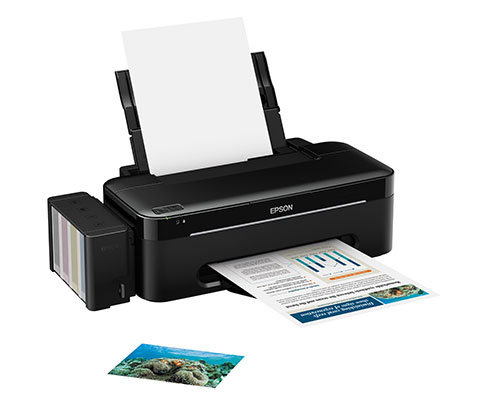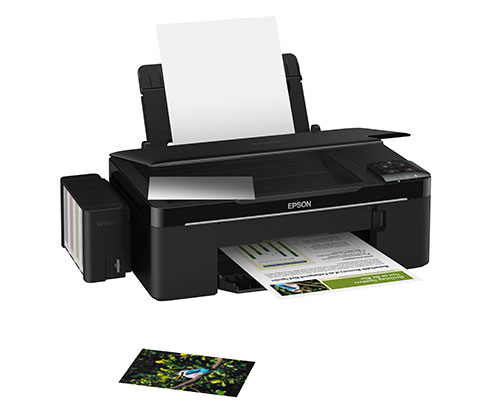L100 & L200 High-Capacity Ink Tank Inkjet Printers
Product Features
October 2010


Specifications
L100 (single-function printer) / L200 (multifunction printer)
Printing method: On-demand inkjet
Nozzle array: 90 black nozzles, 29 color nozzles × 3 colors
Resolution: 5760 × 1440 dpi
Ink: 4 colors (black, cyan, magenta, yellow)
Print speed: Monochrome (A4) Approx. 27 ppm / Color (A4) Approx. 15 ppm / Photo (post card) Approx. 66 seconds per print
External dimensions:* 508 mm × 304 mm × 151 mm (W × D × H)
Weight:* 4.3 kg
Power consumption:* 12.0 W (during operation)
Scanner Specifications*
Type: Color flatbed image scanner
Sensor: CIS
Resolution: 600 × 1200 dpi
Copy Function*
Copy speed: Monochrome text (A4) Approx. 11 seconds / Color text (A4) Approx. 38 seconds
Maximum copies per job: 20
*L200 specifications
These were the world's first printers to use high-capacity ink tanks (70 ml for each color) instead of ink cartridges. With a yield of up to 4,000 prints1 in monochrome, the L100 and L200 achieved the low running costs required for emerging markets while maintaining the high print quality made possible by Epson's Micro Piezo technology.
The user-refillable ink tanks were designed to make the refilling process as easy as possible once the ink ran out. For example, the tanks could be detached from the printer and a narrow tip attached to the refill ink bottle to avoid spills.
The use of high-capacity ink tanks also provided superior environmental performance. Compared with ink cartridge-based printers, these models emit 46% less CO2 during use.2
1 Print yield is calculated using Epson's proprietary testing method based on the ISO/IEC 24712 standard.
2 When compared with the Epson Stylus T13, launched in 2010, based on Epson's evaluation criteria
Story Behind the Creation
In Indonesia, one of the emerging markets expected to drive global economic growth in the future, printing cost is a much more important consideration than print quality when selecting a printer. Many printers, including those made by Epson, were modified with external tanks to deliver low priced but poor quality third-party bottled ink to the print head instead of using the genuine ink cartridges necessary for optimum performance. However, in some cases these modifications led to frequent printing defects and ink leaks, resulting in unexpected repair costs that increased the cost of printing.
The L100 and L200 high-capacity ink tank printers were designed with a total cost that is acceptable to emerging markets, allowing customers to use Epson printers long-term without having to worry about quality problems.
Reception and Market Impact
Both models attracted considerable attention as business printers after their launch in Indonesia and posted strong sales growth. Just one year after launch, the high-capacity ink tank printer models accounted for nearly half of Epson's total printer sales in Indonesia. Sales were expanded to Thailand, India, China and other parts of Asia, and were subsequently expanded to Latin America, Eastern Europe and the Middle East.
The success of these products accelerated Epson's shift to a business model designed to meet the needs of customers in emerging markets.


